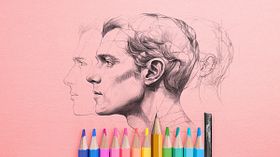@harry_davies
Illustration Tutorial: 5 Basic Tips on How to Shade with Ink

5 basic tips from Sergio Bleda on how to shade with ink and take light into account
Shading gives depth to your drawings: it makes something flat, three-dimensional. Inking and shading are fundamental components of the process of designing a comic. They help us place an object or character, illustrating the space in which they are found and helping the viewer understand where the light is coming from.
Cartoonist and illustrator Sergio Bleda (@sergibleda) shares his tips and tricks on how to shade like an expert with India ink. All you need are: two synthetic brushes (number 1 and number 2), 300gsm Canson paper, and Winsor & Newton India ink.
5 tips on how to shade:
Tip 1: Ink before you shade. It’s important to go over your pencil drawing in ink before beginning the process of shading. This will allow you to visualize the drawing and see how you can start from the lines you have already drawn to create your shadows.

Tip 2: Take what direction the light is coming from into account. Light can come from various angles, so be aware that shadows will always be projected away from the light source. For example, if the light comes from above, the shadows are projected downwards. It is also important to keep in mind what it is that you are shading; what an object is will have a considerable effect on how you shade it. If, for example, you are shading a face, you must respect the volume and shadows of the hair, nose, chin and eyes. Shading each element appropriately will make your face look three-dimensional.

Types of light to consider in your art:
1. Light from above: this is the most common type of light source. The shadows are usually projected under the nose, on the cheeks, between the eyebrows and on the neck.

2. Lateral light: here, one side is much darker than the other.

3. Two irregular light sources: this is a slightly more complicated effect, widely used in American comics. The side where the light is less powerful is made far darker than the other.

4. Back light: this creates a disturbing effect that leaves the face almost totally black, although the brightness of a character’s eyes might be maintained.

5. Light from below: when this occurs, the shadow is projected upwards so the forehead and hair are darkened.

- Tip 3: Darkness is also a type of illumination. Leaving the whole object or character almost entirely dark, except for some key features, is another way to use light in your drawing. Dark scenes can be effective tools in your work and controlling darkness is just as important as controlling light.
- Tip 4: Overlay elements to add depth. When composing a scene, some elements should be above others. It is important to know how to place these elements in order to simulate this 3D effect in which the shadows give the drawing three-dimensionality.
- Tip 5: The rear shadow exists. Objects not only cast shadows on themselves, they also cast shadows behind them. Respecting this effect will add even more depth to your drawing. One way to illustrate this effect is to draw stripes on the background which are directed towards the source of light, behind the main shadow. This will help show how the light source affects the whole scene.

If you want to learn more ways to use ink in your artwork with Sergio Bleda, don't miss his online course, Dye Techniques for Comics and Illustration where you will discover the technical and creative possibilities of professional inking.
You may also be interested in these tutorials:
- Illustration Tutorial: How to Draw from Your Imagination
- Illustration Tutorial: The Color Wheel
- Cinema 4D Tutorial: cloning methods in MoGraph






0 comments